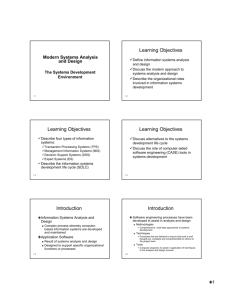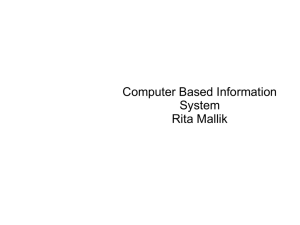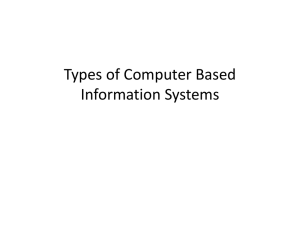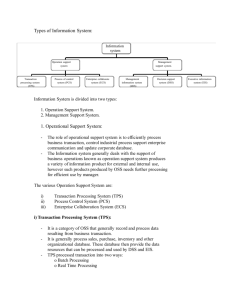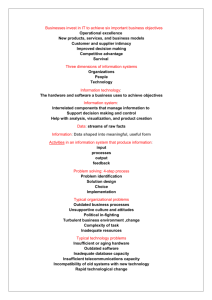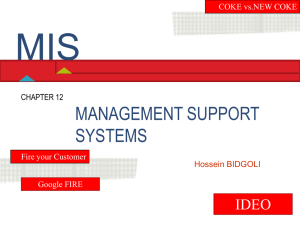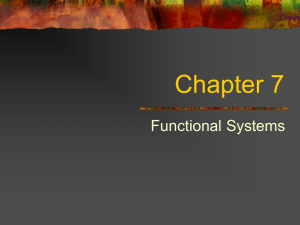SECTION 1: MANAGING INFORMAION SYSTEMS
advertisement
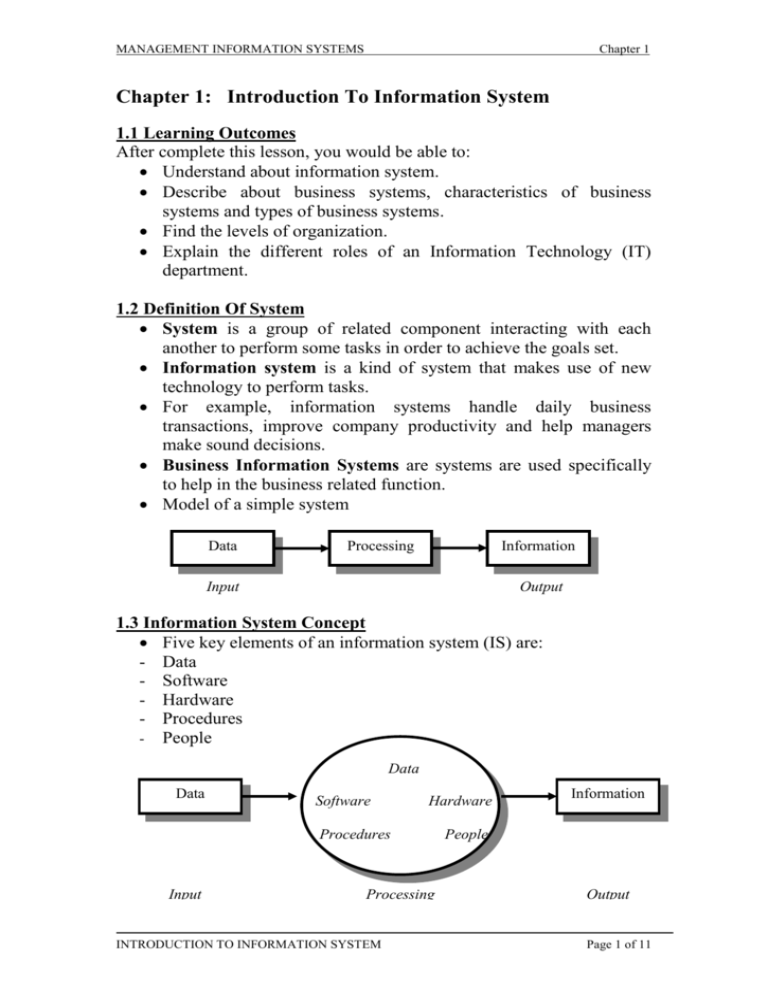
MANAGEMENT INFORMATION SYSTEMS Chapter 1 Chapter 1: Introduction To Information System 1.1 Learning Outcomes After complete this lesson, you would be able to: Understand about information system. Describe about business systems, characteristics of business systems and types of business systems. Find the levels of organization. Explain the different roles of an Information Technology (IT) department. 1.2 Definition Of System System is a group of related component interacting with each another to perform some tasks in order to achieve the goals set. Information system is a kind of system that makes use of new technology to perform tasks. For example, information systems handle daily business transactions, improve company productivity and help managers make sound decisions. Business Information Systems are systems are used specifically to help in the business related function. Model of a simple system Data Processing Information Input Output 1.3 Information System Concept Five key elements of an information system (IS) are: - Data - Software - Hardware - Procedures - People Data Data Software Hardware Procedures Input Processing INTRODUCTION TO INFORMATION SYSTEM Information People Output Page 1 of 11 MANAGEMENT INFORMATION SYSTEMS Chapter 1 Hardware - Hardware refers to the physical layer of the information system. - These include computers, networks, communication equipment, scanners, printers, digital capture devices, Global Positioning Satellite (GPS) equipment and other technology-based infrastructure. Software - Software consists of system software and application software. - System software controls the hardware and software environment and includes the operating system and utility programs that handle common function such as sorting data, converting files into a different format and making backups. - Application software consists of program that process data into information. These might includes spreadsheets, word processors, database management systems, payroll, order entry and accounts receivable program. Data - Data is all information either is produced directly or derived from other data, which is related to a particular system or business. - Data is served as the source to be brought into the information system for processing and so to produce information after that. Procedures - Procedures define the tasks that must be performed by people who work with the system, including users, managers and information system staff. - Procedures typically are described in written documentation / manuals or online reference material. People - Primary purpose of an information system is to provide valuable information to users. - Information system requires the efforts of skilled professional, such as system analysts, programmers and IS managers to build it. - Users, who are sometimes called end users, include employees, customers, vendors or others who directly interact with the system. 1.4 Business Information System Business information system of a company normally consists of a series of subsystems. INTRODUCTION TO INFORMATION SYSTEM Page 2 of 11 MANAGEMENT INFORMATION SYSTEMS Chapter 1 Each of the subsystems is a smaller IS that processes data into useful information. 1.4.1 Characteristics Of Business Information System - Relationships with other systems Business Information Systems often are interdependent. For instance, output information from the purchasing system becomes data input to the production and finance systems. - Boundaries / Scope A boundary between two systems indicates where one system ends and the other begin. The boundary between two systems is not always clear-cut. It takes coordination and proper system definition to set these boundaries correctly. - Specialized business needs In addition to the typical type of Business Information Systems, each system has their own purpose and functions. Two same category of Business Information System might use different procedures in producing the information. Thus, knowing the accurate user requirement is critical. Size of the companies in the same industry may have very different information systems requirements as well. For example, banks can range in size from a local operation with a main office and one or two branches to a multinational bank with branches in many states and foreign countries. 1.4.2 Types Of Business Information Systems Six broad categories of Business Information Systems are: - Operational Systems / Transaction Processing Systems (TPS) - Management Information Systems (MIS) - Decision Support Systems (DSS) - Expert Systems (ES) - Office Automation Systems (OAS) Operational Systems / Transaction Processing Systems (TPS) - An Operational System process data generated by the day-to-day business transactions of a company. - Eg. Coffee shop, bank, clinic, etc. - The purpose of TPS is to computerize an existing manual system for faster processing, reduced clerical costs and improved customer service. INTRODUCTION TO INFORMATION SYSTEM Page 3 of 11 MANAGEMENT INFORMATION SYSTEMS Chapter 1 Steps in processing a transaction: Step 1: Enter Data Step 2: Validate Data Online Transaction Processing (OLTP) Step 3: Process Data Into Info Step 4: Store Processed Data Batch Transaction Processing (BTP) Step 5: Generate Output Step 6: Support User Queries Management Information Systems (MIS) - A computer-based system that generates timely and accurate information for low and middle management in order to monitor and control the internal operations of an organization. - Usually, the information generated by an MIS helps managers understand the day-to-day operations of the company, such as weekly sales, daily production, monthly operating expenses, etc - For example, MIS reports could highlight slow or fast-moving items, customers with past due balances and inventory items that need reordering. - With this kind of information, better management decisions can be made. - Input – TPS & other internal company sources. - Output – Summary & exception report* - Eg. Bank manager – receives a summary report of yesterday’s deposits & withdrawals. Decision Support Systems (DSS) - Frequently, top management needs information that is not provided routinely by operational and management information system. - For instance, management might want to know the effect on company profits if sales increase by 10 percent and costs go up by 5 percent. This type of information sometimes called the what-if analysis, and it needs a DSS to support. INTRODUCTION TO INFORMATION SYSTEM Page 4 of 11 MANAGEMENT INFORMATION SYSTEMS Chapter 1 - DSS helps make business decisions by analyzing internal or external data. - Internal data comes from an organization's own files, while external sources might include information on interest rates, population trends or new housing construction from external bodies. Internal Data Cost of raw material No. of people required for the job Time needed to finish the job External Data State and federal taxes Regulatory requirements Expert Systems (ES) - Also called a (knowledge-base or rule-based system) is one in which the knowledge of one or more human experts along with the rules for applying that knowledge are stored and later accessed for use in decision making. - It is simulate to human reasoning by combining a knowledge base and inference rules that determine how the knowledge is applied. - An expert system examines a problem, defines and assesses solutions to it, and suggests which solutions are better. - There is increasing use of expert system technology to solve realworld problems in many industries. Office Automation Systems (OAS) - Office automation systems have empowered employees and made them more productive in their tasks. - Office systems might include local and wide area networking, electronic mail, voice mail, fax, video conferencing, word processing, automated calendars, electronic filing, database management, spreadsheets, desktop publishing, presentation graphics, company intranets and Internet access throughout the company. Executive Information System (EIS) or Executive Support System (ESS) - Software that analyzes and presents information to executive decision makers in a useful, friendly and customized format and their need to make unstructured decisions. INTRODUCTION TO INFORMATION SYSTEM Page 5 of 11 MANAGEMENT INFORMATION SYSTEMS Chapter 1 - It consists of a set of tools and techniques such as color graphics, touch screens and voice-activated commands that help managers to retrieve, analyze, navigate, summarize and distribute large volumes of data quickly and efficiently. - EIS combines the features and capabilities of both management information systems and decision support systems, but with more flexibility and better support for unstructured decision making. Different between EIS and DSS 1. EIS – used to deliver and display information (Information Delivery) 2. DSS – more appropriate for analyzing problem (Problem Solving) 1.5 Structured, Semi-Structured And Unstructured Decisions Many management decisions are periodic and predictable. For example, companies regularly make decisions regarding minimum inventory levels or customers with past due accounts. The information required for these decisions can be predefined and alternative actions can be specified in advance. These decisions are called structured decision, because they occur regularly, have predefined information requirements and result in predetermined actions. Unstructured decision cannot be predicted and whose information needs cannot be predefined. Unstructured decision making is very common for top managers, where complex issues of corporate strategy and policy are involved. For instance, corporate researchers often try to predict consumer tastes and spending patterns for the next five to ten years. Semi-structured decisions are not as predictable and definable as structured decisions. An example of a semi-structured decision might involve the impact of inflation on production costs. 1.6 Organizational Levels Most companies organize with operational personnel reporting to lower managers, who report to middle managers, who report to top managers. In a corporate structure, top managers report to the board of directors who are elected by the shareholders. INTRODUCTION TO INFORMATION SYSTEM Page 6 of 11 MANAGEMENT INFORMATION SYSTEMS Chapter 1 Top Management CEO, President, Vice President Middle Management Lower Management Operational Personnel Director, Manager Supervisor, Team Leader, Coordinator Sales Representative, Retail Associate, Production Worker, Team Member, Administrative Assistant, Tech Support, Representative, Accounting Clerk, Financial Analyst Operational Personnel - Spend most of their time performing repetitive, day-to-day functions that follow well-defined procedures. - Production-line workers, clerks, sales representatives and auditors are examples of operational personnel. - Operational employees use information system to enter and receive data they need to perform their job. Lower Management - Supervisors or team leaders who supervise the operational employees and carry out day-to-day plans. - They direct operations, ensure that the right tools, materials and training are available, make necessary decisions and take corrective actions. - Most lower-manager decisions are highly structured. - A supervisor's information needs usually are narrow, because he or she only requires information in one area of responsibility. Middle Management - Focus on a longer period plans, usually ranging from one month to one year. - They develop plans and allocate company resources to achieve organizational objectives in a process called tactical planning. - Middle managers delegate authority and responsibility to first-line supervisors and work closely with them to provide direction, necessary resources and feedback on performance. - Most middle management decisions are semi-structured and occur in routine patterns. - Compared to supervisor, middle managers need less detail and more exceptions and summary information. - Exception reports identify variances from set targets and help managers identify situations that require action. INTRODUCTION TO INFORMATION SYSTEM Page 7 of 11 MANAGEMENT INFORMATION SYSTEMS Chapter 1 Top Management - They responsible for long-range planning and they establish the overall company mission, policies and goals, including future products and services. - This type of planning is called the strategic planning, which ensures that the company will survive and grow in the future. - Because top managers are concerned with the entire company, they need information from the entire company. - Many top management decisions are unstructured, top managers also need what-if information from decision support systems to make unstructured decision. - Top management need information from outside the company to address issues involving economic trends, technology, competition, governmental agencies and shareholders. Organizational Level Responsibility Decision Making Top Management Middle Management Develop long-range goals, plans and strategies Develop short-range goals, plans and tactics Unstructur ed Semistructured Lower Management Develop day-to-day plans and supervise operational personnel Perform routine functions Structured Operational Personnel Structured Information Systems Requirements EIS, MIS summaries, DSS, OAS MIS summaries and exceptions, DSS OAS TPS details, some MIS summaries and exceptions, OAS TPS details, ES, OAS. 1.7 Information Technology Department Information Technology (IT) Department develops and maintains a company’s information systems. The structure of the IT department is varies among companies, as does its name and placement within the organization. In a small firm, one person might handle all computer support activities and services, whereas a large corporation might require many people with specialized skills to provide information system support. The IT group provides technical support, which includes six main functions: application development, systems support, user support, database administration, network administration, and web support. These functions overlap considerably and often have different names in different companies. INTRODUCTION TO INFORMATION SYSTEM Page 8 of 11 MANAGEMENT INFORMATION SYSTEMS Chapter 1 Director Information Technology Application Development Systems Support and Security User Support Database Administration Network Administration Application Development Traditionally, IT departments had an application development group composed of systems analysts and programmers who handled information system design, development, and implementation. Today, many companies use development teams consisting of users, managers, and IT staff members for those same tasks. Systems Support and Security Systems Support provides vital protection and maintenance services for system h/w and s/w support including enterprise computing systems, network, transaction processing systems, and corporate IT infrastructure. The systems support and security group implement and monitors physical and electronic security hardware, software and procedures. They install and support operating systems, telecommunications s/w, and centralized database mgmt systems. User Support User support provides users with technical information, training, and productivity support. This function usually called a help desk or information center (IC). A helpdesk staff trains users and managers on application s/w such as e-mail, word processors, spreadsheets, and graphic packages. In many companies, the user support team also installs and configures s/w applications that are used within the organization. Although user support specialists coordinate with other technical support areas, their primary focus is user productivity and support for user business process. INTRODUCTION TO INFORMATION SYSTEM Page 9 of 11 Web Support MANAGEMENT INFORMATION SYSTEMS Chapter 1 Database Administration Database administration involves database design, mgmt, security, backup, and user access in a large company. However, in small and medium-sized companies, IT support persons perform those roles in addition to other duties. Regardless of company size, mission-critical database applications require full-time attention and technical support. Network Administration Business operations often depend on networks that enable multi-user data access and processing. It includes h/w and s/w maintenance, support, and security. In order to controlling user access, network administrators install, configure, manage, monitor, and maintain network applications. Web Support Web support specialists, often called webmasters, support a company’s Internet and intranet operations. It involves design and construction of Web pages, managing h/w and s/w, and linking Web-based applications to the company’s existing information systems. The Systems Analyst position A system analyst investigates, analyzes, designs, develops, installs, evaluates, and maintains a company’s information systems. To perform those tasks, systems analyst constantly interacts with users and managers within and outside the company. On large projects, the analyst works as a member of IT department team, whereas he or she might work alone on smaller assignments. As a member of a functional team, an analyst is better able to understand the needs of that group and how information systems support the department’s mission. Responsibilities The systems analyst’s job overlaps business and technical issues. An analyst translate business requirement into practical IT projects that meet the company’s needs. They perform a wide array of tasks, such as building business profiles, reviewing business process, selecting h/w and s/w packages, designing information systems, training users, and so on. They also plan projects, develop schedules, and estimates costs. INTRODUCTION TO INFORMATION SYSTEM Page 10 of 11 MANAGEMENT INFORMATION SYSTEMS Chapter 1 Skills required A systems analyst needs solid technical knowledge, strong oral and written communication skills, problem solving skills, good analytical ability, and an understanding of business operations and processes. They need to have good interpersonal skills to deal with people at all levels, from operation staff to senior executives, including people outsider like s/w and h/w vendors, customers, and government officials. Analyst also maintains their skills by attending training courses and workshops. Review Questions 1. Define information system. 2. Explain the organizational levels in an organization. 3. Differentiate between Executive Information System (EIS) and Decision Support System (DSS). 4. Discuss the roles of information technology department. INTRODUCTION TO INFORMATION SYSTEM Page 11 of 11

